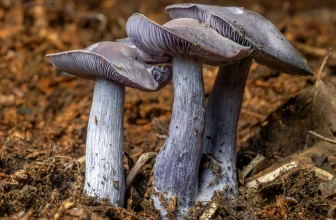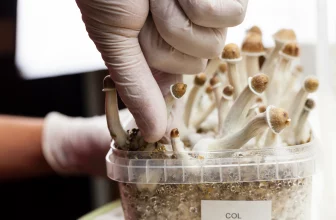
The magic truffle, scientifically known as psilocybe tampanensis, is a rare, hard-to-find psychedelic mushroom in the Psilocybe family. This shroom is also widely known as the philosopher’s stone.
There are currently 14,000 different species of mushrooms known to exist. Just over 180 of these 14,000 mushrooms are psychoactive (that is, they contain psilocybin). Each species differs significantly in its appearance, habitat, potency, and potential dangers.
Mycologists (fungi experts) have characterized and genetically isolated many mushroom strains. Because of each species’ distinct genetic makeup, each species produces a unique mushroom experience. Further, potency varies from batch to batch, even within the same species. This is partially a result of the different growing environments around the world. Various amounts of psilocybin are present in all known species of magic mushrooms.
Table of Contents
Some Science Behind Magic Truffles
The mycelium structure of a mushroom consists of branching, fine white filaments. These delicate thread-like fibers contain psychoactive substances. Occasionally, a mushroom’s mycelia produce sclerotia, a dense ball of those delicate strands.
Sclerotia are rare forms of defense against wildfires and other natural disasters produced by fungi; if a disaster occurs, sclerotia ensures that the mycelium can stay safe and protected underground.
The lump of fine white filaments then dries out and stores nutrients. This dense ball of psychotropic goodness is a magic truffle with reported levels of psilocybin ranging from 0.31% to 0.68%. Potency levels depend on the substrate in which the magic truffles were grown.
In short, Psilocybe tampanensis is a unique mushroom that can transform into a magic truffle.
The Fascinating History Behind Magic Truffles
Mycologist Steven H. Pollock made a peculiar discovery in 1977. The mushroom expert frequently collected samples of mushrooms for his mobile laboratory, which he drove from Texas to Tampa, Florida. However, Pollock could never have predicted the surprise that awaited him that summer.
Pollock skipped a “boring conference” to go mushroom hunting and found a single, unrecognized specimen growing in a sand dune. The mycologist later cloned the specimen and produced a pure sample, which remains widely circulated as magic truffles today.
The researcher spent weeks growing the unidentified Psilocybe in his lab. Then, many tiny lumps developed on the mycelium. Mycelium typically appears as tiny cobwebs dispersed throughout the soil, but these lumps more closely resembled kefir grain.
The lumps grew bigger over time. Pollock described, dissected, and sampled the chunks, sharing the findings of his investigations which made clear the real treasure Pollock possessed: a novel species. And one that was also psychoactive.
He gave the unusual specimen the name Psilocybe tampanensis in honor of Tampa, where he discovered the magic truffle.
Where Does Psilocybe Tampanensis Grow?
Magic truffles grow in humid, subtropical areas in the eastern half of the United States, from Florida all the way to Texas along the Gulf Coast, even extending to Mexico.
Magic truffles are a rare subtropical species. They grow alone or in groups in meadows and sandy soils. But because P. tampanensis is so scarce, scientists don’t actually know its preferred habitat with certainty. What is known, though, is that this mushroom, like all Psilocybe species, is saprotrophic and grows on decaying plant matter.
Unfortunately, there’s not a lot of information on the outdoor cultivation of magic truffles. The only place Psilocybe tampanensis was known to grow for almost two decades was the locale in which Pollock found the original.
Another scientist eventually spotted this mysterious mushroom again in 1996 in Pearl River County, Mississippi, in a meadow with sandy soil.
What Do Magic Truffles Look Like?
You’re fortunate if you ever find Psilocybe tampanensis growing in the wild. You’re doubly lucky if you can recognize this shroom, too, because it looks like any other brown little mushroom growing in the wild.
Its convex cap is 1 to 2.4 centimeters in diameter, with a slight umbo (the nipple-like structure you see on most mushrooms). The caps change color as they dry out, and they can look beige to yellowish-gray. With time, the cap flattens out and sometimes develops a slight depression in the middle. When wet, the smooth surface turns sticky.
When injured, the flesh bruises blue and is white to yellowish. Both the flavor and aroma are reminiscent of freshly ground flour; this aroma is known as farinaceous.
Because of the gills’ adnate attachment, the stem serves as their primary attachment point. They have lighter-colored edges and a brown to dark purple-brown coloration. The mushroom leaves purple-brown spore prints. A cobweb-like layer that peels away as the gills develop partially covers the gills. This is a characteristic shared by many in the Psilocybe family.
The Effects of Magic Truffles (and Are Magic Truffles Legal?)
The fact that truffles can be more expensive to buy than psilocybin-containing mushrooms is a drawback of the legal truffle market. However, you’re paying for the assurance that the truffles have come from dependable producers and are appropriately dosed.
When dried, psychedelic truffles have a lower psilocybin content than dried magic mushrooms, but they still have enough to produce a powerful psychedelic experience.
People frequently claim that the psychedelic experience is less intense and lasts less time than the magic mushroom trip, but this is probably because truffles are produced with greater care and packaged with accurate dosage information. In contrast, people are more likely to take an unknown dosage of magic mushrooms because they are frequently purchased from questionable sources.
You should only buy and ingest magic truffles in places where it is legal to do so. Psilocybin and psilocin are listed as Schedule I drugs in the United States.






